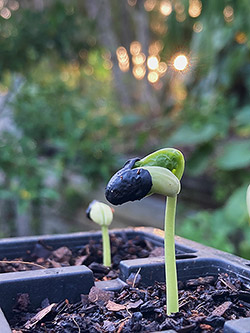Articles
Bean There, Tried That

When it comes to growing beans, it’s tempting to stick to the old "dig a hole and bury the seed" method. But what if we told you there’s a better way? For improved germination and healthier plants, try planting your beans on the surface of the soil rather than burying them deep. This has been an experiment we here at Eden Seeds have put to the test this season, after reading the tip from a seed savers blog . Working on heavy clay soil where we are, we immediately thought, this is garden gold and had to try it. Glad we are, as it has worked a treat! No more mouldy, mushy or otherwise lost beans here!
Why Surface Planting Works
Beans, whether bush or climbing varieties, are particularly sensitive to their environment during germination. Here’s why letting them start closer to the surface can give them a better chance:
Moisture Control: Beans need consistent moisture to sprout, but burying them too deep can lead to waterlogging, which might cause rot. Placing them on the surface allows you to control the balance of moisture more effectively.
Better Access to Oxygen: Seeds need oxygen to germinate, and heavy or compacted soil can suffocate them. Keeping beans near the surface gives them better air circulation.
Avoiding Soil Compaction: Deep planting can mean seeds struggle to push through dense soil, especially in clay-heavy gardens. Surface planting gives them a head start and ensures they don’t expend all their energy just trying to break through.
How to Surface Plant Beans
Prepare Your Soil: Loosen the top layer of soil, removing any large clumps. A fine, crumbly surface works best.
Lay the Seeds: Space your bean seeds evenly on top of the soil, following the spacing recommendations for the variety you’re planting (usually about 10–15 cm apart).
Cover Lightly: Sprinkle a very thin layer of soil or compost over the seeds—just enough to keep them anchored and protected. You want to be able to still see the beans.
Water Gently: Use a soft spray or mist to water the seeds, ensuring the soil stays moist but not soggy.
Mulch Wisely: Once the beans sprout, adding a light layer of mulch can help retain moisture and suppress weeds.
Spotlight on the Scarlet Runner Bean
Here’s a fun bean to try with this method: the Scarlet Runner Bean. Loved for its striking red flowers and vigorous vines, this heirloom isn’t just a showstopper—it’s also a multitasker. Native to Central America, it’s been cultivated for centuries as both a food crop and an ornamental plant. The beans are delicious fresh or dried, and the flowers attract all kinds of pollinators, making it a win-win for your garden. Also known as the Seven Year Bean, this vigorous climber has a unique ability to re-sprout from its roots in frost-free climates, making it a perennial treasure for many gardeners. The beans themselves are as beautiful as the flowers, with black and purple seeds so captivating they’ve been used to create stunning jewellery.
Pro Tip: Scarlet Runner Beans germinate particularly well with the surface planting method, especially in warm, moist conditions. Give them a sunny spot and a trellis, and watch them take off!
The Results? More Sprouts, Happier Beans
Surface planting lets your beans germinate faster, with fewer losses due to rot or compaction. Once they’ve sprouted and sent their roots into the soil, they’ll establish themselves just as strongly as deeply planted beans—if not more so!
So this season, give your beans the star treatment. Keep them close to the surface and watch your germination rates soar.
Happy planting,




